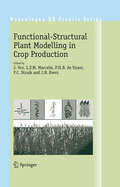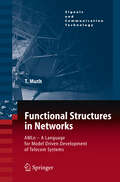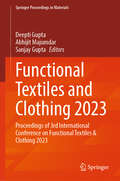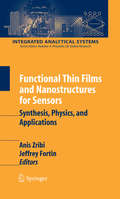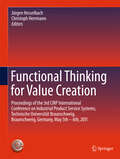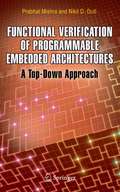- Table View
- List View
Functional Smart Nanomaterials and Their Theranostics Approaches (Smart Nanomaterials Technology)
by Alle Madhusudhan Shiv Dutt Purohit Rajendra Prasad Azamal HusenThis book covers a number of engineered nanotheranostics platforms and nanomedicines applications of FDA-approved medicines for early-stage diagnosis and treatment of cancer. The book focuses on (i) the basic design and bioengineering of safe medicines, (ii) physicochemical understanding of surface engineered medicines and their characteristics, (iii) various examples for site-specific bioimaging and multimode therapies, (iv) stimuli-responsive approaches for targeted drug delivery applications, (v) targeted therapeutics approaches for cancer cells or solid tumor ablations, (vi) targeted mechanisms of administrative biomedicines, (vii) impact of surface modification or engineering of biomedicines for site-selective tumor binding ability, and (vii) requirements for clinical trials and FDA approval. The content of this book appeal to readers who are interested in recent developments of FDA-approved cost-effective rapid cancer imaging and therapeutic platforms.
Functional Starch and Applications in Food
by Zhengyu JinThis book discusses functional starch and its applications in food, focusing on starches with possible health benefits or novel applications. Covering slowly digested starch, resistant starch, porous starch, starch microemulsions, microcrystalline starch and noncrystallization starch and their applications, this book provides a valuable reference for graduate students and research professionals in the food and chemical industries.
Functional Statistics and Applications: Selected Papers from MICPS-2013 (Contributions to Statistics)
by Elias Ould Saïd Idir Ouassou Mustapha RachdiThis volume, which highlights recent advances in statistical methodology and applications, is divided into two main parts. The first part presents theoretical results on estimation techniques in functional statistics, while the second examines three key areas of application: estimation problems in queuing theory, an application in signal processing, and the copula approach to epidemiologic modelling.The book’s peer-reviewed contributions are based on papers originally presented at the Marrakesh International Conference on Probability and Statistics held in December 2013.
Functional-Structural Plant Modelling in Crop Production (Wageningen UR Frontis Series #22)
Functional-structural plant models (FSPMs) describe in quantitative terms the development over time of the three-dimensional (3D) structure of plants as governed by physiological processes and affected by environmental factors. FSPMs are particularly suited to analyse problems in which the spatial structure of the plant or its canopy is an essential factor to explain, e.g., plant competition (intra-plant, inter-plant, inter-species) and the effects of plant configuration and plant manipulation (e.g., pruning and harvesting) on yield and produce quality. This book describes the philosophy of functional-structural plant modelling and several tools for making FSPMs; it outlines methods for measuring essential parameters, including those pertaining to plant structure. As FSPMs offer new opportunities to model sink–source interactions, the physiological theory and modelling approaches regarding partitioning of carbon are given specific attention. Examples of application of FSPMs include wheat modelling in the context of remote sensing and the analysis of predator–prey insect interactions on glasshouse plants. The book will be useful for scientists and advanced students interested in innovative approaches in plant and crop modelling.
Functional Structures in Networks: AMLn - A Language for Model Driven Development of Telecom Systems (Signals and Communication Technology)
by Thomas G. MuthDesigned to make life easier for most network designers, whether they are a manager with technical background, work with standardization, the architecture of implementers’ solutions to standards, product design (constructing the software and hardware parts of operator networks), system testing, and for operators responsible for the configuration and maintenance of a network. Develops modeling as a basic principle for producing specifications turns design from being document driven to model-driven. In the context of this book, however, the only model type that is discussed is the information model that describes the purpose, structure, and behavior of a network. Presents an added-value modeling language that called AMLn (Abstract Modeling Language, network view), which is the first and, so far, the only attempt to create a modeling language for network systems.
Functional Supramolecular Architectures: For Organic Electronics and Nanotechnology
by Paolo Samorí Franco CacialliA comprehensive overview of functional nanosystems based on organic and polymeric materials and their impact on current and future research and technology in the highly interdisciplinary field of materials science. As such, this handbook covers synthesis and fabrication methods, as well as properties and characterization of supramolecular architectures. Much of the contents are devoted to existing and emerging applications, such as organic solar cells, transistors, diodes, nanowires and molecular switches. The result is an indispensable resource for materials scientists, organic chemists, molecular physicists and electrochemists looking for a reliable reference on this hot topic.
Functional Supramolecular Architectures: For Organic Electronics and Nanotechnology
by Paolo Samorí Franco CacialliA comprehensive overview of functional nanosystems based on organic and polymeric materials and their impact on current and future research and technology in the highly interdisciplinary field of materials science. As such, this handbook covers synthesis and fabrication methods, as well as properties and characterization of supramolecular architectures. Much of the contents are devoted to existing and emerging applications, such as organic solar cells, transistors, diodes, nanowires and molecular switches. The result is an indispensable resource for materials scientists, organic chemists, molecular physicists and electrochemists looking for a reliable reference on this hot topic.
Functional Surfaces in Biology: Adhesion Related Phenomena Volume 2
by Stanislav N. GorbThis book is devoted to the rapidly growing area of science dealing with structure and properties of biological surfaces in their relation to particular function(s). This volume, written by a team of specialists from different disciplines, covers various surface functions such as protection, defense, water transport, anti-wetting, self cleaning, light reflection and scattering, and acoustics. Because biological surfaces have a virtually endless potential of technological ideas for the development of new materials and systems, inspirations from biology could also be interesting for a broad range of topics in surface engineering.
Functional Surfaces in Biology: Little Structures with Big Effects Volume 1 (Biologically-inspired Systems Ser. #10)
by Stanislav N. GorbFunctional Surfaces in Biology III: Diversity of the Physical Phenomena (Biologically-Inspired Systems #10)
by Stanislav N. Gorb Elena V. GorbThis book is devoted to the rapidly growing area of science dealing with structure and properties of biological surfaces in their relation to particular functions. This volume, written by a team of specialists from different disciplines, covers various biological surface functions: sensing, coloration, attachment, drag reduction, moisture harvesting, etc. Because biological surfaces have a virtually endless potential of technological ideas for the development of new materials and systems, inspirations from biology could also be interesting for a broad range of topics in surface engineering. This volume together with two previous volumes “Functional Surfaces in Biology” (vols. 1 & 2 published in 2009) taken together, present a good reference for a novice in the field. The book is intended for use by researchers who are active, or intend to become active, in the field. The appeal of this topic is expected to be broad, ranging from classical biology, biomechanics and physics to such applied fields as materials science and surface engineering.
Functional Textiles and Clothing
by Abhijit Majumdar Deepti Gupta Sanjay GuptaThis volume contains select papers presented during the Functional Textiles and Clothing Conference 2018. The book covers the recent scientific developments, cutting edge technologies, innovations, trends, challenges and opportunities in the field of functional and smart textiles and clothing. The contents of this volume will be of interest to researchers, professional engineers, entrepreneurs, and market stakeholders interested in functional textiles and clothing.
Functional Textiles and Clothing 2020
by Abhijit Majumdar Deepti Gupta Sanjay GuptaThis volume contains select papers presented during the Functional Textiles and Clothing Conference 2020 held at Indian Institute of Technology Delhi. The volume covers recent developments, challenges and opportunities in the field of functional and protective clothing; functional printing and finishing; sustainable production and supply chain; and testing and characterisation. This volume will be of interest to researchers, professional engineers, entrepreneurs, and market stakeholders interested in functional textiles and clothing.
Functional Textiles and Clothing 2023: Proceedings of 3rd International Conference on Functional Textiles & Clothing 2023 (Springer Proceedings in Materials #42)
by Deepti Gupta Abhijit Majumdar Sanjay GuptaThis volume contains selected papers presented during the Functional Textiles and Clothing Conference 2023 held at the Indian Institute of Technology Delhi. The volume focuses on Design of Adaptive clothing for special populations such as people with visual impairment or motor disabilities and the elderly. Design of protective clothing for fire fighters, chemical protective clothing and comfort of protective clothing is discussed. Other topics include recent advancements in the field of sustainable dyeing and finishing, dyeing of natural fibres and use of natural dyes and surface functionalisation of textiles. New and emerging fibres from plant and animal sources, development of novel blends and their characterisation are other topics included in this volume. The book will serve as a good reference for researchers working in the emerging area of Functional clothing and Textiles.
Functional Thin Films and Nanostructures for Sensors: Synthesis, Physics and Applications (Integrated Analytical Systems)
by Anis Zribi Jeffrey FortinThis book discusses advances in functional thin films for sensors and novel concepts for future breakthroughs. The focus is on guidelines and design rules for sensor systems, interaction between functional thin films and other sensor subsystems, fundamentals behind the intrinsic functionality in sensing thin films and nanostructures, state-of-the-art technologies used to develop sensors today and concrete examples of sensor designs.
Functional Thin Films Technology (Advances in Materials Science and Engineering)
by Sam Zhang Jyh-Ming Ting Wan-Yu WuFunctional Thin Films Technology features the functional aspects of thin films, such as their application in solar selective absorbers, fiber lasers, solid oxide fuel cells, piezo-related areas, catalysts, superhydrophobicity, semiconductors, and trace pesticides detection. It highlights developments and advances in the preparation, characterization, and applications of functional micro-/nano-scaled films and coatings. This book Presents technologies aimed at functionality used in nanoelectronics, solar selective absorbers, solid oxide fuel cells, piezo-applications, and sensors Covers absorbers, catalysts, anodic aluminum oxide, superhydrophobics, and semiconductor devices Features a chapter on transport phenomena associated to structures Discusses transport phenomena and material informatics This second volume in the two-volume set, Protective Thin Coatings and Functional Thin Films Technology, will benefit industry professionals and researchers working in areas related to semiconductors, optoelectronics, plasma technology, solid-state energy storages, and 5G, as well as advanced students studying electrical, mechanical, chemical, and materials engineering.
Functional Thin Films Technology (Advances in Materials Science and Engineering)
by Sam Zhang Jyh-Ming Ting Wan-Yu WuFunctional Thin Films Technology features the functional aspects of thin films, such as their application in solar selective absorbers, fiber lasers, solid oxide fuel cells, piezo-related areas, catalysts, superhydrophobicity, semiconductors, and trace pesticides detection. It highlights developments and advances in the preparation, characterization, and applications of functional micro-/nano-scaled films and coatings. This book Presents technologies aimed at functionality used in nanoelectronics, solar selective absorbers, solid oxide fuel cells, piezo-applications, and sensors Covers absorbers, catalysts, anodic aluminum oxide, superhydrophobics, and semiconductor devices Features a chapter on transport phenomena associated to structures Discusses transport phenomena and material informatics This second volume in the two-volume set, Protective Thin Coatings and Functional Thin Films Technology, will benefit industry professionals and researchers working in areas related to semiconductors, optoelectronics, plasma technology, solid-state energy storages, and 5G, as well as advanced students studying electrical, mechanical, chemical, and materials engineering.
Functional Thinking for Value Creation: Proceedings of the 3rd CIRP International Conference on Industrial Product Service Systems, Technische Universität Braunschweig, Braunschweig, Germany, May 5th - 6th, 2011
by Jürgen Hesselbach Christoph HerrmannAfter the IPS² conferences in Cranfield and Linköping in 2009 and 2010 the 3rd CIRP International Conference on Industrial Product Service Systems (IPS²) 2011 takes place in Braunschweig, Germany. IPS² itself is defined as “an integrated industrial product and service offering that delivers value in use”. The customers expect comprehensive solutions, which are adapted to their individual needs. IPS² offers the possibility to stand out from competition and for long-term customer loyalty. Particularly in times of economic crisis it becomes apparent which producing companies understand to satisfy the needs and requirements of their customers. Especially in this relatively new domain IPS² it will be important to keep track of the whole context and to seek cooperation with other research fields and disciplines. The 3rd CIRP International Conference on Industrial Product Service Systems (IPS²) 2011 serves as a platform for such collaborations and the discussion of new scientific ideas.
Functional Tissue Engineering
by Farshid Guilak David L. Butler Steven A. Goldstein David Mooney-Softcover reprint of a successful hardcover reference (370 copies sold) -Price to be accessible to the rapidly increasing population of students and investigators in the field of tissue engineering -Chapters written by well-known researchers discuss issues in functional tissue engineering as well as provide guidelines and a summary of the current state of technology
Functional Verification Coverage Measurement and Analysis
by Andrew PizialiThis book addresses a means of quantitatively assessing functional verification progress. Without this process, design and verification engineers, and their management, are left guessing whether or not they have completed verifying the device they are designing. Using the techniques described in this book, they will learn how to build a toolset which allows them to know how close they are to functional closure. This is the first book to introduce a useful taxonomy for coverage of metric classification. Using this taxonomy, the reader will clearly understand the process of creating an effective coverage model. This book offers a thoughtful and comprehensive treatment of its subject for anybody who is really serious about functional verification.
Functional Verification of Dynamically Reconfigurable FPGA-based Systems
by Lingkan Gong Oliver DiesselThis book analyzes the challenges in verifying Dynamically Reconfigurable Systems (DRS) with respect to the user design and the physical implementation of such systems. The authors describe the use of a simulation-only layer to emulate the behavior of target FPGAs and accurately model the characteristic features of reconfiguration. Readers are enabled with this simulation-only layer to maintain verification productivity by abstracting away the physical details of the FPGA fabric. Two implementations of the simulation-only layer are included: Extended Re Channel is a System C library that can be used to check DRS designs at a high level; ReSim is a library to support RTL simulation of a DRS reconfiguring both its logic and state. Through a number of case studies, the authors demonstrate how their approach integrates seamlessly with existing, mainstream DRS design flows and with well-established verification methodologies such as top-down modeling and coverage-driven verification.
Functional Verification of Programmable Embedded Architectures: A Top-Down Approach
by Prabhat Mishra Nikil D. DuttIt is widely acknowledged that the cost of validation and testing comprises a s- nificant percentage of the overall development costs for electronic systems today, and is expected to escalate sharply in the future. Many studies have shown that up to 70% of the design development time and resources are spent on functional verification. Functional errors manifest themselves very early in the design flow, and unless they are detected up front, they can result in severe consequence- both financially and from a safety viewpoint. Indeed, several recent instances of high-profile functional errors (e. g. , the Pentium FDIV bug) have resulted in - creased attention paid to verifying the functional correctness of designs. Recent efforts have proposed augmenting the traditional RTL simulation-based validation methodology with formal techniques in an attempt to uncover hard-to-find c- ner cases, with the goal of trying to reach RTL functional verification closure. However, what is often not highlighted is the fact that in spite of the tremendous time and effort put into such efforts at the RTL and lower levels of abstraction, the complexity of contemporary embedded systems makes it difficult to guarantee functional correctness at the system level under all possible operational scenarios. The problem is exacerbated in current System-on-Chip (SOC) design meth- ologies that employ Intellectual Property (IP) blocks composed of processor cores, coprocessors, and memory subsystems. Functional verification becomes one of the major bottlenecks in the design of such systems.
Functionality of Cyclodextrins in Encapsulation for Food Applications
by Thao M. Ho Hidefumi Yoshii Keiji Terao Bhesh R. BhandariCyclodextrins (CD) are cyclic oligosaccharides containing 6, 7 or 8 glucose units (α, β or γ-CD, respectively) in a truncated molecular shape. Their cyclic molecular structure contains a hydrophilic surface and a hydrophobic cavity at the center that can interact (host) with external hydrophobic compounds (guest molecules). Cyclodextrins have been categorized as Generally Recognized As Safe (GRAS) in the USA, “natural products” in Japan, and as “novel food” in Australia, New Zealand and EU countries. They are therefore widely used in food production to encapsulate hydrophobic compounds, including solid, liquid and gas molecules, in order to solubilize, stabilize or control the release rate of these components. To date, there has been no comprehensive review of the very large number of studies performed on encapsulation using cyclodextrin powders for food applications in recent years. This text fills that gap for academics in the encapsulation field and for industry professionals who want to gain a solid understanding of encapsulation functionality of cyclodextrin powders. The book consists of 16 chapters in which chapter 1 introduces cyclodextrin properties and its applications in food processing, and chapters 2-16 explore applications of cyclodextrin in encapsulation for many guest compounds. These compounds include gases, flavors, colors, pigments, polyphenols (plant bioactive compounds), essential oils, lipids (cholesterol and polyunsaturated fatty acids), vitamins, fruit ripening controlling compounds, and antifungal and antimicrobial compounds. These chapters also discuss functionalities of cyclodextrin in packaging, masking off-flavor and off-taste, and as dietary fiber. Covering a broad range of cyclodextrin applications and suitable for both newcomers to encapsulation technology and those with experience, Functionality of Cyclodextrins in Encapsulation for Food Applications is a unique and essential reference on this increasingly important topic.
Functionality of Molecular Systems: Volume 2: From Molecular Systems to Molecular Devices
by Kenichi HondaMolecular systems are assemblies of molecules designed to possess special qualities and desired functionality. Such systems are important because they provide materials with novel properties, and they will be particularly useful for minimizing electronic devices. In this two volume work, the first volume, subtitled 'From Molecules to Molecular Systems', covered the fundamentals of molecular design, while volume 2 deals with the potential applications of molecular systems. Information transduction and energy conversion are the basis of any practical device, and these considerations, along with the required interconnections and interfaces, are analyzed to produce the architectural design for a molecular system. The preparation of molecular systems is also considered, including that of self-organizing molecular assemblies, ultrathin films, and ultrafine particles.
Functionality of Proteins in Food
by Joseph F. ZayasThe book is devoted to expanding current views on the phenomena of protein functionality in food systems. Protein functionalities in foods have been the object ofextensive research over the last thirty to forty years and significant progress has been made in understanding the mechanism and factors influencing the functionality of proteins. The functionality of proteins is one of the fastest developing fields in the studies of protein utilization in foods. Currently, a broad spectrum of data related to protein functionality in food systems has been collected, however, much more needs to be known. In this volume, the most important functional properties offood proteins are presented: Protein solubility, water holding capacity and fat binding, emulsifying, foaming, and gelling properties as affected by protein source, environmental factors (pH, temperature, ionic strength) and protein concentration; Relationships between protein conformation, physicochemical properties, and functional properties; Protein functional properties as influenced by various food processing conditions, particularly heat treatment, dehydration, freezing and storage when frozen, extraction and other processes; Effects ofprotein modification on the enhancementofprotein functionality; Utilization ofvarious proteins in improving functional properties in food systems. Those aspects of protein functionality are presented which the author believes to be interesting and most important for protein utilization in food systems. The book is recommended to students and food scientists engaged in food protein research and food industry research, and development scientists. Table ofContents Introduction 1 References 5 Chapter 1 Solubility ofProteins. . . . . . . . . . . . . . . . . . . . . . . . . . . . . . . . . . . . . . . . . . 6 1. 1 Introduction. . . . . . . . . . . . . . . . . . . . . . . . . . . . . . . . . . . . . . . . . . . . . . . . . . . . . . . . . . . . . 6 1. 1. 1 Factors Affecting Solubility ofProteins. . . . . . . . . . . . . . . . . . . . . . . .
Functionalization of Molecular Architectures: Advances and Applications on Low-Dimensional Compounds
by Kazuhiro ShikinakaLow-dimensional compounds are molecules that correspond to various shapes, such as rod, ladder (one-dimensional compounds), and sheet (two-dimensional compounds). They are ordinarily found in electromagnetic fields. Recently, versatile low-dimensional compounds were proposed for use as components of various functional materials. These new-class low-dimensional compounds contribute significantly to industrial/materials sciences. The molecular architecture consisting of low-dimensional compounds can also be found in nature. One example is the cell cytoskeleton, which is a network- or bundle-like architecture consisting of rod-like protein assemblies. The cell accomplishes its motility by structural transition of the cytoskeleton—that is, phase transition of the architecture of low-dimensional compounds in response to some stimuli induces shape changes in cells. Another example is nacre, which is composed of layered aragonite platelets, usually a metastable CaCO3 polymorph. The layered inorganic platelets give nacre its stiffness and noncombustibility. Thus, the molecular architecture of low-dimensional compounds in natural life contributes to their functionality. This book reviews various advanced studies on the application of low-dimensional compounds and is, therefore, important for the development of materials sciences and industrial technologies.



